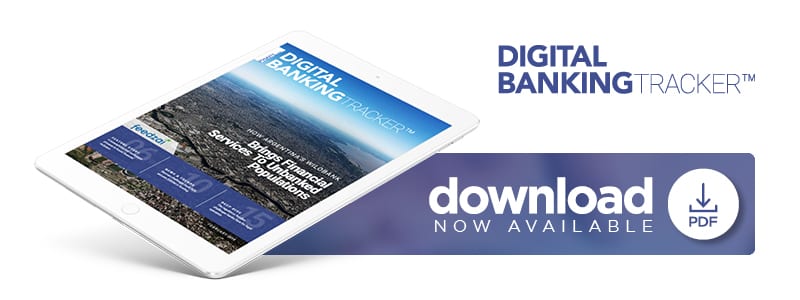How Argentina’s Wilobank Brings Financial Services To Unbanked Populations

In Latin America, where roughly 70 percent of the population is unbanked due to traditional banks’ stringent KYC requirements, digital-only challenger banks see an opportunity to increase financial access. In the latest Digital Banking Tracker, Wilobank President Guillermo Francos and systems director Mariano Durán discuss the Argentinian bank’s smartphone-centric approach for expediting onboarding and promoting financial inclusion.
The challenger bank movement is continuing to gain steam in Europe, attracting customers frustrated with traditional banks’ offerings and investors eager to fund a force to disrupt the financial services market. The challenger bank trend has recently been pushing beyond the EU and is now entering the Latin American market.
Approximately 70 percent of the region’s residents do not have bank accounts, making digital-only challenger banks particularly appealing. Their smartphone-centric financial services approaches do not require customers to visit physical bank branches, and delivering accessible financial services via smartphones could make Latin America a ripe market for challenger banks.
Several challenger banks, such as Nubank, Neon and Uala, have emerged to bring unbanked Latin American residents into the financial services system. Nubank and Neon cater to Brazilian consumers, and Uala is based in the Argentinian market. While these FIs are offering users different banking approaches and bringing new participants into the digital economy, they must still take the time to confirm that their customers are who they claim to be.
Argentinian challenger Wilobank (formerly Wanap) does this through a combination of motion-based biometrics and smartphone-based KYC review. PYMNTS recently spoke with Wilobank’s president, Guillermo Francos, and systems director, Mariano Durán, about how the bank ensures the trustworthiness of its customer base and how it is promoting financial inclusion.
“We were born because the old system is dying,” Francos said. “If you go to a physical bank, you have to deal with paperwork, and it takes a lot of time and you have to answer a lot of questions. You can lose several days [onboarding] a client to the bank.”
A Smartphone-centric Approach to Onboarding and KYC
One appealing aspect of challenger banks is that they enable consumers to quickly apply for bank accounts right from their smartphones — something traditional banks in Latin America have failed to deliver. Delivering seamless financial services has become challenger banks’ mantra, but they need to be sure their onboarding processes are still as stringent as those of traditional banks.
Wilobank’s onboarding process is done entirely via a smartphone. When opening a new account, customers snap photos of official Argentinian identification documents, such as driver’s licenses. They are then asked to perform basic physical movements in front of their cameras. These selfie-style liveliness checks, Durán said, help Wilobank confirm that new users are who they claim to be.
“We compare the snapshots taken in that process to make sure they are a human being and compare that with the photo on the ID,” Durán explained.
Comparing the images on official IDs with those captured during the motion-reading process verifies the authenticity of the users interested in onboarding and eliminates the threats of bad actors in possession of similar-looking photos. The process, which has been approved by Argentina’s central bank, allows Wilobank to feel confident about its onboarding procedures. At the same time, interested parties can join the digital-only bank without having to complete cumbersome paperwork or visit a bank branch.
Giving a Financial Services Lifeline to the Unbanked
This smartphone-centric approach is just one of the ways in which Wilobank is able to compete for consumers. According to Francos, onboarding can be challenging at traditional banks because they are only willing to accept customers who meet a certain income threshold or who can demonstrate steady employment.
“Traditional banks … are used to avoiding risk,” Francos said. “They are oriented to have clients … who have a certain incomes and who they can [count on] to be good clients.”
These rigid requirements can leave many people out of the financial fold, Francos said, adding that Wilobank addresses this by taking a holistic view of clients’ information, including their credit scores, whether they make timely rent payments and a host of other data points.
So far, this approach has allowed the bank to offer financial services, including personal loans and credit cards, to those who might have previously been unable to access them. Wilobank’s customers who have not had a chance to build up their credit scores can be issued credit cards with lower balances, enabling them to make purchases and establish a credit history.
“The most important thing we give them is the possibility to get inside the system,” Francos said.
This approach has allowed Wilobank to quickly expand its user base. It has gained approximately 30,000 users since its launch in early 2018, and it hopes to reach 300,000 by next year. On top of that, Wilobank hopes to give customers younger than 18 access to bank accounts to promote financial literacy.
Focusing on younger demographics could pay off for challenger banks because these users are more interested in smartphone-based, digital-only banking experiences. Attracting these consumers and bringing previously unbanked populations into the digital banking ecosystem could help challenger banks live up to their names by enabling them to shake up the financial status quo.

